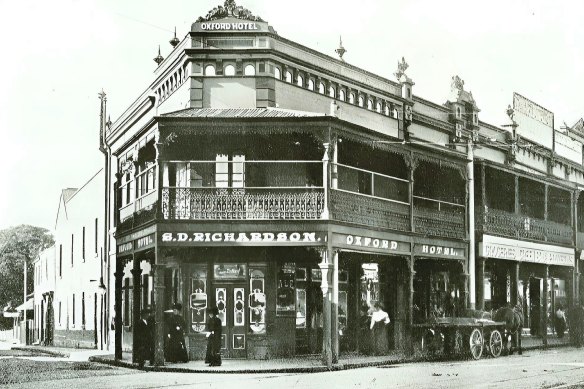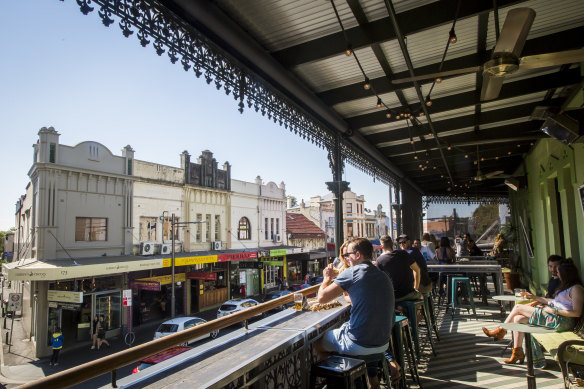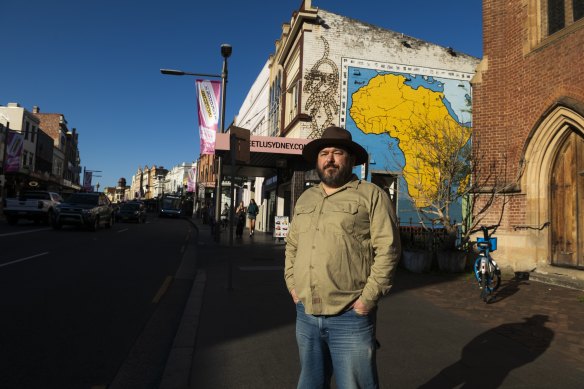
323 King Street Newtown in all its glory.
Australia’s cities were once home to commercial buildings with wide verandahs, which provided shade and ambience at street level and above. Not quite inside or outside, they were perfect places to stop for a natter, take in the street or have a beer.
Most have been removed. Now inner west resident James Cottam is leading a charge to bring them back. He mourns the removal of what he estimates has been 70 per cent of Newtown’s historic deep verandah awnings that can make a hot day feel a lot cooler.
They would improve public amenities, expand the footprint of restaurants and bars, and increase the appeal of Newtown’s King Street, said Cottam, a former photo editor for Nine (the owner of this masthead), who is now a real estate agent.

More verandahs like this would turn Newtown into a tourist destination.Credit: Anna Kucera/Destination NSW
Where these wide verandahs had been restored, including at the popular Newtown Hotel and in Adelaide’s East End on Rundle Street, the venues have gone off like a “frog in a sock”, he says. That led to other restaurants and venues restoring theirs.
If they were restored, the area – with most of King Street’s original shops still standing – could become a destination for tourists interested in architecture and heritage, similar to New Orleans’ French Quarter.
A Facebook page Cottam launched documents verandahs and balcony awnings. They were once considered the “most distinctively Australian feature” of local architecture, featuring in courthouses and public buildings from about 1805.
That was until the emergence of the “The Balcony Problem”.
This phrase was used in more than 1000 news reports across Australia starting in the late 19th century, documenting complaints about structural problems, adults and children falling off them, and neighbours arguing over who owned what. They’re still considered a mix of private and public space.
As cars began to dominate, motorists claimed the verandah posts were a hazard. By 1908, they had been banned in Newtown and other places, though they have since been reinstated with more modern safety standards.
In May 1884, a visitor to Perth, Sam Frearson, was shocked to find opposition to balconies and verandahs, considering they provided shelter from the tropical sun.
Adelaide, Sydney, and Melbourne had them, he wrote. A wide verandah “adorns the street from whatever point of view you may look … How any person can be found so stupid as to oppose them in the fair city of Perth is a mystery,” he wrote.
According to urban heat expert Professor Sebastian Pfautsch, these verandahs show people like Frearson understood the climate, which has only become more extreme since.
“Just picture someone in the 1860s wearing heavy boots and clothes in the stifling heat. Nobody was planting street trees,” said Pfautsch, who is with the School of Social Sciences at Western Sydney University.
Deep awnings blocked 100 per cent of radiant heat, improving the comfort level – the “feels like” indicator – by as much as 15 degrees, he said.

James Cottam wants to see balconies and verandahs restored on historic King Street in Newtown.Credit: Rhett Wyman
”Without an awning, it is like a baking oven. Things [in shops] would melt and perish, it was hard to see what was behind the glass. There are many benefits of having a long, deep verandah: it can be used for cooling or to have a nice glass of wine.”
Some verandahs were a city block long, like the Newtown Hotel’s, which is now about half its original size. Cobar Hotel in north-west NSW boasts the longest and widest verandah in Australia.
Help! What is the difference beween an awning, balcony and a verandah?
Sydney City Council defines them as:
Awning – A cantilevered horizontal or predominantly horizontal roof-like structure projecting from a building and providing shelter to the footpath.
Verandah – An awning supported on posts rather than cantilevered.
Balcony – A horizontal projecting platform on a building (whether cantilevered or supported on posts) enclosed by a balustrade.
Along King Street, Cottam spots clues revealing which businesses’ verandahs were removed. Windows have been installed where doors once opened on to verandahs. If a new awning has replaced the original, it is a different height and doesn’t reach the street.
Cottam points to a corner where two food venues face each other. Both show hints of original verandahs, but Mr Potato has restored its verandah, while Kuletto’s has an ugly industrial awning.
A spokesperson for the Inner West Council said they supported the reinstatement of balconies where there was evidence they once existed because they enhanced the private use of historical buildings.
Dr Jennifer Preston, chair of the Australian Institute of Architects’ NSW heritage committee, said: “We should definitely bring them back if the public safety issues can be addressed. They not only provide shade from the sun but also make shopping or being out in public more pleasant in rainy weather.”
Start the day with a summary of the day’s most important and interesting stories, analysis and insights. Sign up for our Morning Edition newsletter.